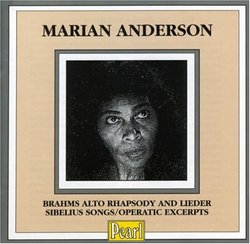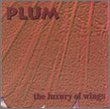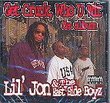| All Artists: Johannes Brahms, Gaetano Donizetti, Camille Saint-Saens, Jean Sibelius, Spiritual Traditional, Charles Haynes, Eugene Ormandy, Philadelphia Orchestra, Kosti Vehanen, Marian Anderson Title: Marian Anderson: Brahms Alto Rhapsody & Lieder Members Wishing: 0 Total Copies: 0 Label: Pearl Release Date: 1/4/1993 Genres: New Age, Pop, Classical Styles: Vocal Pop, Opera & Classical Vocal, Historical Periods, Modern, 20th, & 21st Century Number of Discs: 1 SwapaCD Credits: 1 UPC: 727031940524 |
Search - Johannes Brahms, Gaetano Donizetti, Camille Saint-Saens :: Marian Anderson: Brahms Alto Rhapsody & Lieder
 | Johannes Brahms, Gaetano Donizetti, Camille Saint-Saens Marian Anderson: Brahms Alto Rhapsody & Lieder Genres: New Age, Pop, Classical
|
Larger Image |
CD DetailsSimilar CDs
|
CD ReviewsFive stars for the music, much less for some poorly remade r Larry VanDeSande | Mason, Michigan United States | 09/06/2007 (4 out of 5 stars) "Here's a sometimes scratchy and wiry reminder of the artistry of American Marian Anderson (1897-1993), an American contralto about whom Arturo Toscanini said she had a voice heard once in a hundred years.
Anderson, a native Philadelphian, debuted with the New York Philharmonic in 1925 and scored an immediate success. She first sang at Carnegie Hall in 1928 and her reputation, like Paul Robeson's in the same period,was furthered by European tours where she did not encounter the racial prejudices she endured at home. Andreson became such a fixture in American society a commemorative postage stamp was created to honor her memory in 2005 as part of the Black Heritage series. She is also pictured on the $5,000 Savings Bond. Anderson works here from sometimes clear, sometimes scratchy 78 productions of Brahms' Alto Rhapsody, songs & opera excerpts by Brahms, St. Saens and Sibelius, and some American classics, sometimes abetted by Ormandy and the Philadelphia Orchestra. Elsewhere, Kosti Vehanen accomapnies the contralto in this memento, among other things repeating their famous duet at Washington's Lincoln Memorial in 1939. Vehanen worked with her in Europe to master some of the Scandanavian repertory included in this recording. The gem of this collection is the Anderson-Ormandy collaboration in Brahms' Alto Rhapsody. The pair perfectly reflect the composer's heartbreak when he composed it as a wedding gift for Robert Schumann's daughter. Brahms silently longed for the girl and portrayed his unstated love through the music, which first reflects his melancholy and later seems to suggest a certain emotional accommodation against the forces at work. Anderson and Ormandy are flawless in a good transfer from 1937. The singer perfectly captures the moment in each stanza and the male chorus comments on the composer's state of mind with equal potence. This is musicmaking on the highest plane of technical and emotional achievement. After this, the remaining songs & excerpts, a varied group, never display the same intensity of emotion. The concert is polished off with a couple American spirituals, repertory where the singer is most at home. This memento will suit anyone that wants to better understand what made Marian Anderson an American icon in classical music and song during the Depression, before the war, and in the years afterward. Younger listeners used to being accommodated by DDD and SACD should make mental allowance for the sound, which is sometimes below any standard you may be used to. " |

 Track Listings (13) - Disc #1
Track Listings (13) - Disc #1

